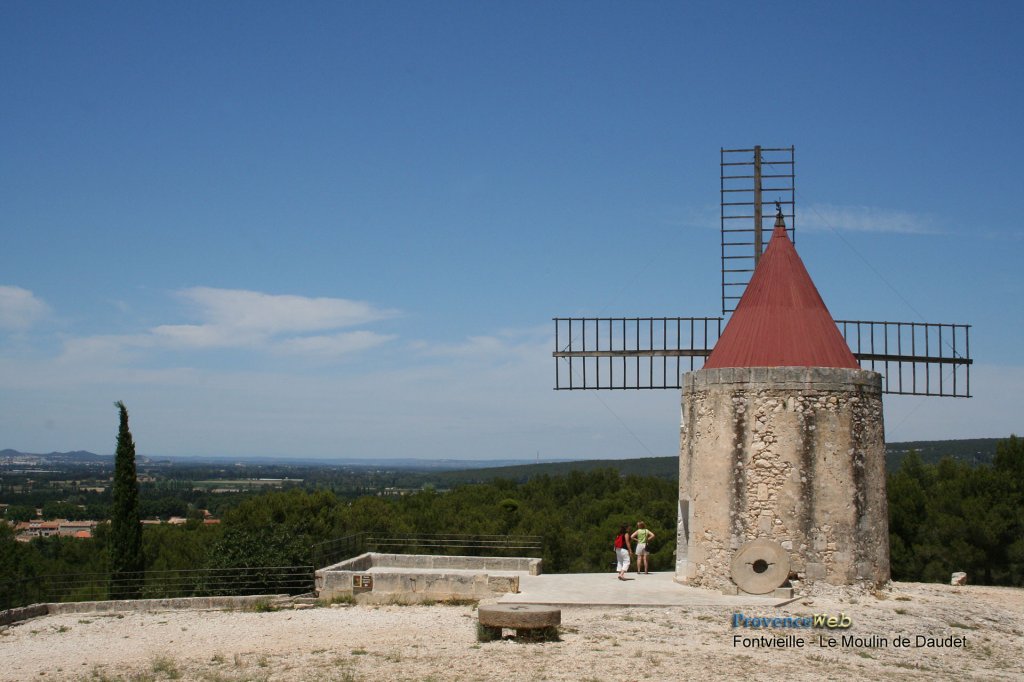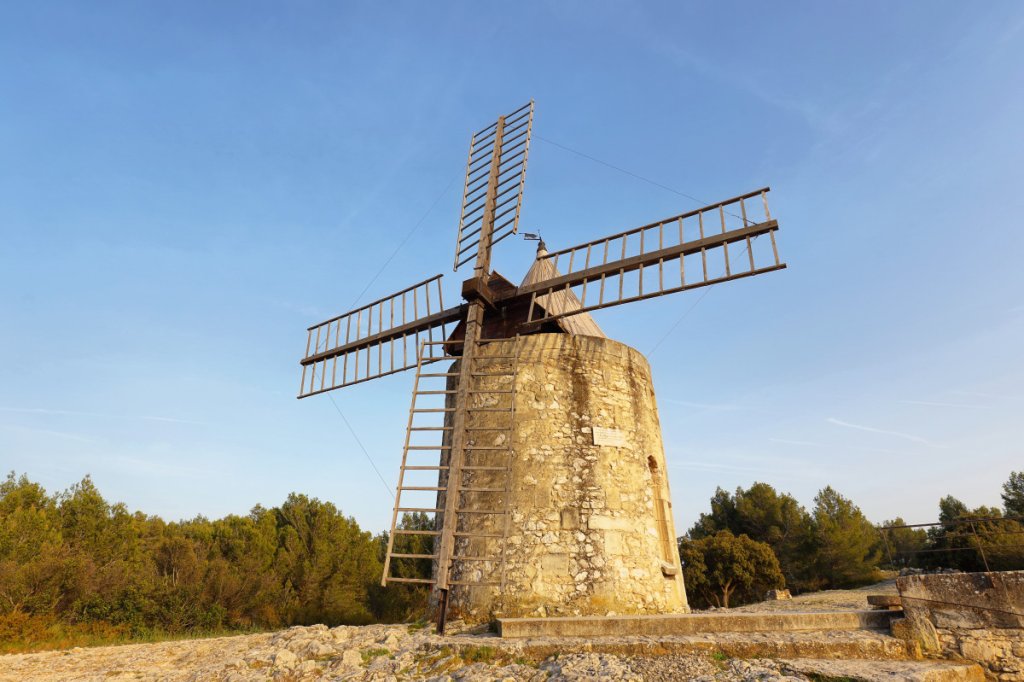Emblematic of the writer Alphonse Daudet, Fontvieille windmill invites you to take a trip back in time. Recently renovated, it reveals itself through a fascinating tour in the heart of Provence. The Saint-Pierre windmill, better known as Daudet’s windmill, is one of Fontvieille's most famous windmills. A place steeped in history, where strolls and discoveries await you.

The Saint Pierre windmill: a symbol of Provence
The Saint-Pierre windmill, also known as Ribet’s windmill, was built in 1814. Originally used to grind wheat, it ceased operations in 1915 when grain was requisitioned for the Great War. The mill is particularly well preserved thanks to the restoration undertaken by the Association des Amis d'Alphonse Daudet in 1935.
Situated on a hill to the west of the allée des pins, the Saint-Pierre windmill offers an exceptional panoramic view of the Alpilles. Visit the downstairs room and discover a permanent exhibition dedicated to the writer.
You can also explore other mills in the area, such as the Ramet windmill and the Tissot-Avon windmill, which are part of the Sentier des Moulins. This family-friendly walk takes you through the enchanting landscapes that inspired Daudet.

Windmill visit: prices and times
The Alphonse Daudet’s windmill is open daily from 11:00 am to 6:00 pm from April to November, and from 10:30 am to 7:00 pm in July and August. A single admission fee of 2 euros is charged to all visitors.
Advance booking is recommended, especially for groups. The owner, keen to preserve the mill's authenticity, has set up these arrangements to ensure a pleasant experience. For more information, contact the Fontvieille Tourist Office.
Visitors can explore the interior of the mill, with its period mechanism and a small museum dedicated to Alphonse Daudet. There's also a store selling souvenirs to prolong this unique experience.

Fontvieille, the village that inspired Daudet
The small village of Fontvieille, nestled in the Alpilles mountains, was a haven of peace for Alphonse Daudet. Seduced by the charm of Provence, he spent his vacations here, far from the hustle and bustle of Paris. The picturesque landscapes and people of the village inspired many of the characters in his works.
You can explore the famous Château de Montauban, where Daudet often stayed, invited by his cousin Louis and his wife Octavie. This place of calm and rest has become a museum center dedicated to the writer, allowing visitors to immerse themselves in his world.
In addition to the château, the local flora and fauna offer a total immersion in the atmosphere that so marked Daudet. Hiking trails take you through the fragrant hills, where windmills still stand proudly.

The Sentier des Moulins (“windmills walk”): a walk through history
Alphonse Daudet's “Sentier des Moulins” in Fontvieille is an unmissable walk for lovers of history and literature. This accessible, family-friendly trail takes in four emblematic local windmills: the Saint-Pierre windmill, the Ramet windmill, the Tissot-Avon windmill and the Sourdon windmill.
The mills, although not in operation, offer a fascinating insight into the trades of yesteryear. For example, the Tissot-Avon mill, near the Château de Montauban, was a favorite gathering place for Daudet. Here, you can feel the inspiration behind his famous works.
Along the way, interpretation panels will guide you and tell you about the history of each mill. The beauty of the Provencal landscapes adds a poetic dimension to this walk, paying tribute to the writer whose words continue to enchant readers.

The mill through Alphonse Daudet's letters
Alphonse Daudet immortalized the Fontvieille mill in his collection “Letters from my mill”, published in 1869. These letters, written with great sensitivity, testify to his deep attachment to Provence.
In “Le Secret de maître Cornille”, Daudet describes the mill as a place full of life and mystery. Millers work hard, and mills, with their majestic wings, symbolize pride and resistance in the face of new technologies.
Some of the letters also evoke the enchanting landscapes of Fontvieille. Daudet depicts the hills, lavender fields and olive groves, adding a poetic dimension to his stories.
These detailed descriptions allow readers to immerse themselves in the world of Provence, and to feel the same fascination for this corner of paradise as the author did.
Photos and maps of where Daudet lived
Below you'll find photos that capture the beauty and authenticity of Daudet's windmill. These images show the mill from different angles and in different seasons, offering a unique perspective on this historic site.
You can easily locate the exact location of Daudet's Mill on this interactive map:
This makes it easy to spot other mills in the village, such as the Ramet windmill and the Tissot-Avon windmill.
For those planning a visit, the maps include key points of interest such as the Château de Montauban, where Daudet loved to recharge his batteries.
These visual resources enrich the visitor's experience, providing a better understanding of the setting that so inspired the writer.

Why is the mill associated with Alphonse Daudet?
The association between the mill and Alphonse Daudet has its roots in the collection “Letters from my mill”, published in 1869. Daudet never lived in the mill, but he found his inspiration while strolling nearby.
Saint-Pierre windmill was restored in 1935 by the Société des Amis d'Alphonse Daudet. They have created a museum dedicated to the writer in the basement of the mill, where you can discover objects and manuscripts by the author.
Daudet's stories are deeply imbued with the Provencal atmosphere he found in Fontvieille. His detailed descriptions of the hills, lavender fields and olive groves immerse us in 19th-century Provence.
For visitors, the mill represents a literary and historical journey, offering an immersive experience in Daudet's world.
The windmill's impact on Daudet's work
The Fontvieille mill had a profound influence on Alphonse Daudet's work. The mill was not just a setting, but a veritable muse for the writer. Every visit to the mill fed his imagination, offering colorful landscapes and characters.
Daudet captured the essence of Provence in his vivid descriptions. The rustle of the mill's wings, the song of the cicadas, and the breathtaking views of the surrounding hills find a vibrant echo in his stories. In “La Mule du Pape”, for example, he uses the mill as a symbol of waiting and perseverance.
“Letters from my mill" is full of authentic details, paying tribute to rural life and its inhabitants. This realistic approach combined with a touch of fantasy enabled Daudet to create timeless works that continue to captivate readers.
Where is the novel “Letters from my mill” set?
“Letters from my mill” takes place mainly in Provence, in the village of Fontvieille. Alphonse Daudet set several of his stories there, including “Le Secret de maître Cornille” and “La Mule du pape”.
The Saint-Pierre windmill, now known as Daudet's mill, is a central feature of the collection. This picturesque spot, surrounded by hills and lavender fields, embodies the Provencal soul described by the author. It is here that Daudet draws inspiration to depict colorful characters and scenes of rural life.
Daudet also evokes enchanting landscapes such as olive groves and fragrant hills. These immersive descriptions allow readers to fully feel the ambiance of 19th-century Provence.

